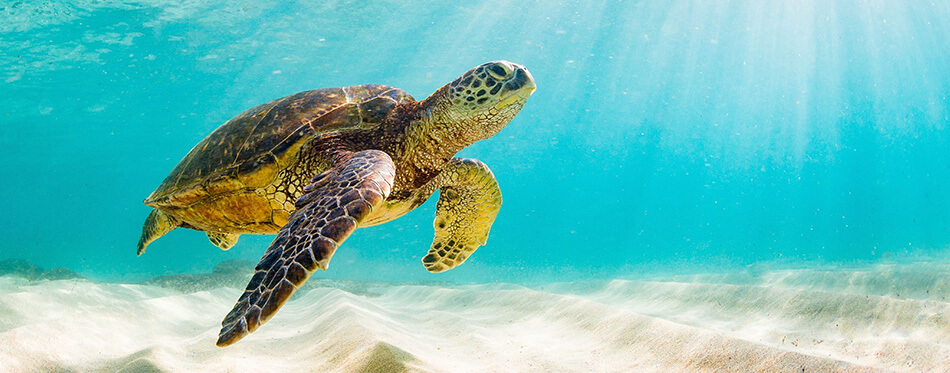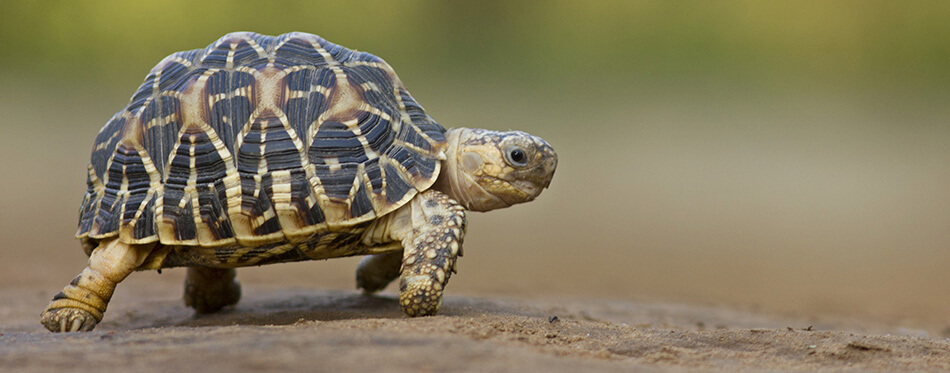Ever wondered what’s the difference between a turtle and a tortoise? You are not the only one! Whilst these fascinating animals may look quite similar at first glance, there is a huge difference between turtles and tortoises. We looked into their appearance, lifestyles and personalities in great detail to get you the answers you want.
To save you having to play spot the difference between turtle and tortoise – take a look at what we found out.
Difference Between Turtle and Tortoise – the Science
A lot of confusion in the turtle vs tortoise debate stems from the terminology. The scientific fact is that they are both members of the turtle animal family! The scientific name for this family is Testudines but they are commonly all referred to as turtles. There are more than 200 members of this group including the terrapin. Therefore, turtles and tortoises have a lot in common! This includes:
- A hard beak around their mouth – they have no teeth
- A hard shell there to provide protection
- Fused rib cage and vertebra attached to their shells
- Their pelvic girdle sits inside the rib cage
- They lay eggs on land in nests that they dig into earth or sand
- Are cold blooded reptiles relying on their environment to maintain their body temperature
On a superficial level, tortoises and turtles are similar but when you delve deeper into their physical appearance, their habitat, and their behavior, there are some major differences.

Turtles and Tortoises Habitats
Turtles are very versatile when it comes to their habitats. Many of these reptiles live in aquatic environments but not all turtles are sea turtles. Some are semi-aquatic and some live on land (terrestrial). Even turtles that live in water come onto the land to lay their eggs.
Tortoises live on land. They are not equipped for swimming and you will not find them living in water. The difference in their habitats has resulted in some subtle physical differences as each has adapted to suit their surroundings. The bodies of aquatic turtles are adapted for swimming but they do not all live totally in water. Some are partly aquatic which means that they spend part of their time on land and part in the water. Others spend most of their time on land but still return to water occasionally. At the other end of the scale is the sea turtle that only leaves the sea to lay eggs.
Turtle vs Tortoise Physical Appearance
Turtle vs Tortoise Shell
Animals that move around in water need streamlined shells and an efficient way of propelling themselves around. Look closely at the shells of turtles and tortoises and you will see some interesting differences.
Turtles generally have a streamlined shell that allows them to move through the water easily. However, there are some notable exceptions! The Box Turtles have domed shells – they are not seen very often as pets as they get stressed by being handled and are easily injured. The Eastern Box Turtle also has high, dome shaped shells that are usually brown or black with a yellow or orange radiating pattern.
Webbed or Rounded Feet
As you would expect, turtles have webbed feet. They use their legs to swim and their webbed feet allow them to propel themselves through the water with ease. Sea turtles have front limbs like flippers and their hind limbs can also be webbed. Other turtles, such as the Snapping turtle, have long claws on their webbed feet. Box turtles are an exception – they do not have webbed feet or flippers!
In contrast to the sea turtle and other turtles, tortoises have tiny elephant feet which are great for them to dig burrows when tortoises lay eggs. Tortoises stay away from water because they cannot swim! Tortoise feet are stumpy with scaly toes that are strong enough to carry their weight around.
Turtle or Tortoise Scute Shedding?
Scutes are the thick, horny plates on the shell of turtles. As they grow, turtles shed their scutes to make room for new ones. When they bask in the sun, the scutes dry out and flake off although turtles can often be seen rubbing their shells on rocks or trees to speed this process up.
Tortoises do not shed their shells. The keratin grows constantly with the new tissue growing without shedding, pushing up old growth to give the shell a layered look. It’s thought this compounded growth helps bulk up their shells to protect them from attack by predators.
Difference in Size Between Turtles and Tortoises
Both can be very large animals! The largest species of turtle is the Leatherback sea turtle. These impressive creatures can weigh up to 700 kg and can be up to 1.7 m long.
Tortoises are famous for reaching huge sizes. The giant Galapagos tortoises weigh over 400 kg and are over a meter in length.
Therefore, turtles can be bigger on the whole. However, there are many species of both turtles and tortoises and they vary greatly in size.
Other Ways in Which Tortoises and Turtles Differences
Turtles and tortoises also have very different diets, ranges of habitats and lifespans.
When you keep them as pets, it is important that you use this information to provide them with what they need to keep them happy and healthy.
Diets of Turtles and Tortoises
The diets of turtles and tortoises have adapted so that they can get all the nutrients they need from the habitats where they live.
Tortoises are mainly herbivores (they eat plants) but different species of tortoise eat different food and their diet also varies by age. These animals spend a lot of time eating as they travel slowly around quite a wide area. You will find tortoises eating a variety of plants including leaves and grass but they are also quite fond of vegetables and fruit. Tropical tortoises will eat insects in the wild but only in very small quantities.
Because turtles live in a more aquatic habitat, their diet is different. Some turtles are herbivores, some are omnivores and some are carnivores. The differences in their diet are often reflected in their jaw shape and function. Green sea turtles have finely serrated jaws and eat mainly sea grass and algae. The Hawksbill turtle, however, has a narrow head and pointed jaw so that it can reach sea sponges in ocean coral reefs. Leatherbacks eat small fish and jellyfish. The Loggerheads have jaws that are strong enough to crush the bony shell of a crab!
Range of Habitat
Tortoises and turtles are members of the reptile family and need the warmth of the sun to maintain their body temperature. Therefore, they live in the parts of the world that are warmer – the semi tropical climates. You will find both tortoises and turtles on the floor of wet tropical forests that are found in many parts of the world including Thailand, Indonesia and Australia.
However, they are both highly adaptive and can be found on every continent of the world except for Antarctica.
Do Turtles or Tortoise Live Longer?
When it comes to lifespan tortoises are the outright winners! In general, reptiles tend to have quite long lifespans. Most tortoises can live for 90 years but the exact lifespan is often linked to their size. The larger the tortoise – the longer the lifespan. Larger tortoises have been known to live for nearly 200 years or more. The current world record is held by Jonathon, a giant tortoise from the Seychelles who now lives on the Atlantic island of St Helena. He was born around 1832, making him the oldest land animal on record. Some experts have suggested that tortoises in the wild have lived for up to 300 years.
The turtle does not have such impressive longevity but they can still live for many years. On average, they live for 30 years but it can be much longer. The average lifespan for a Sea turtle is 65 years.
Tortoise and Turtle Reproduction
On the face of it, the reproductive habits of the tortoise and turtle look quite similar. They both lay eggs on land which hatch live young. However, the turtle digs a hole in the sand, lays her eggs and then leaves. When the young turtles hatch, they find their own way to the ocean to start their life alone.
The tortoise builds a nest for her eggs. She also stays around for a few weeks to look after her young when they have hatched.
Tortoise
- Shell: Domed, hard and thick
- Feet: Elephant-like feet with stumpy toes
- Diet: Nearly always herbivore
- Lifespan: Can be hundreds of years
- Size: Up to 400kg
- Reproduction: Digs hole in sand and leaves eggs
Turtle
- Shell: Streamlined with scutes that can be rubbed off
- Feet: Flippers or webbed feet
- Diet: Can be herbivore, omnivore or carnivore
- Lifespan: Average of 65 years
- Size: Up to 700 kg
- Reproduction: Lays eggs in nest and stays for a few weeks

What About Terrapins?
Terrapins are a reptile and are also in the turtle family. There are several different species of terrapin including the Diamondback terrapin which has a diamond pattern on the top of its dome shaped shell.
The terrapin lives in wetlands but lie in between the tortoise and the turtle. Their shell can be dome shaped but it is quite hard. Terrapins are excellent swimmers but do not have true flippers in the way that many turtles do. Their diet consists of plants as well as small fish and insects and terrapins can be quite aggressive with a powerful snapping jaw that is strong enough to sever a human finger!
On the whole, they are smaller than tortoises but a terrapin called the Alligator Snapping Turtle can grow up to 80 kg in weight.
Sources:
- How to Tell a Turtle From a Tortoise – Liz Langley, National Geographic
- TROPICAL RAINFOREST TORTOISES AND TURTLES – Andy Highfield, Tortoise Trust

